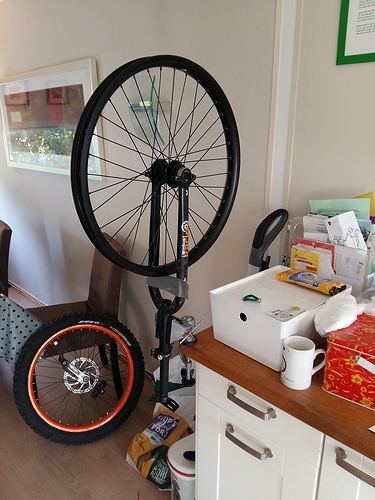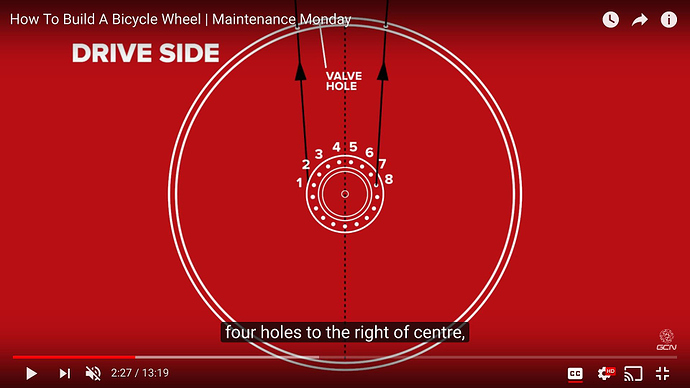(You don’t have to read this post either - you can go directly to the video links below)
For my build I used:
-Nimbus Drift Trike disc hub
-Nimbus Dominator2 24" rim
-36 spokes (3 cross pattern)
I’ve spent quite a bit of money at the local bike shop on wheel building and wheel adjustment over the years. I’ve been wanting to learn this myself, but never really found the time or energy to get on with it. On an impulse I bought a Nimbus Drift Trike disc hub for my Oracle 24" frame, so now was the time to learn. After I did this build, the wheel is no longer a big mystery to me, and I will now be able to maintain my 15 wheels myself.
Ordering spokes (the hard part):
I remembered reading something about dished wheels (explained in video below), and differerent spoke lengths on the disc side and none disc side of the hub. To find the spokes needed, I tried to use a spoke calculator (https://www.unicycle.uk.com/calculator/), but I didn’t really understand it. The hub I ordered was not in the list, so I had to try to meassure it myself. This is where I got confused because with a disc hub you have to calculate spoke length twice: disk side and none disc side. I tried with some of the preset disc hubs in the spokes calculator list and discovered that the value “Flange Width” varied depending on disc/none disk side. From the illustration this didn’t make any sense to me, and I didn’t understand the explanation either. I finally discovered that the meassurements I needed was stated i the product descripton, but it was called “Hub Width” instead of “Flange Width” (Hub Width disc side: 31mm, Hub Width non disc: 66mm). The spoke calculator gave the values 227.03mm (none disc side) and 225.17mm (disc side). According to Sheldon Brown I should round up to the nearest millimeter. Roger says you should go short rather than long, so I guess it depends on what spoke lengths are available. I ordered 226mm and 228mm. I later discovered that the double bottom of the Dominator2 rim made the spoke length less critical than I first thought.
The next question was which “gauge” I should order. Gauge is the diameter of the spoke. 12 gauge is 2.6mm , 13 gauge was out of stock and 14 gauge is 2.0mm. The 12 gauge spokes was not available in shorter lengths than 375mm, so 14 gauge was my only (and correct I think) choice.
Finally the nipples. Nipples has to be ordered separately even though they are in the same photo as the spokes. Because I rounded the spoke length up, I decided to go whith the shortest nipples which is 14 gauge / 12mm. This was also a correct choice.
Preparation:
I don’t have a truing stand so I bought a cheap vice that you can attach to a table with an 90° angle to hold the frame (see picture below).
A zip tie on the frame to correct sideways run outs
A piece of duct tape beneath the wheel to correct circular run outs
Linseed oil in the nipples after advice from bungeejoe i another post (to provide some lubrication when lacing and truing the wheel and then to act as a bit of a thread-lock to keep spokes from easily loosening)
What I didn’t have:
Dishing tool - I just meassured the distance between the frame and rim to get the wheel approximately in the center of the frame. I noticed that my original Oracle wheel was quite a bit off center, so I figured It didn’t have to be that accurate.
Spoke tension meter - I just tried to feel with my hands how tight the spokes on my original Oracle wheel is, and tried to make the new wheel the same. I might buy a spoke tension meter for my 36" wheel later.
The instructional videos:
I watched both these excellent videos once beforehand, and also parallel to the building process.
How to lace a wheel with 36 spokes (17 minutes): https://www.youtube.com/watch?v=_6Sd3bMeDck
How to tighten and truing the wheel (39 minutes): https://www.youtube.com/watch?v=MmQRRNyeCes



